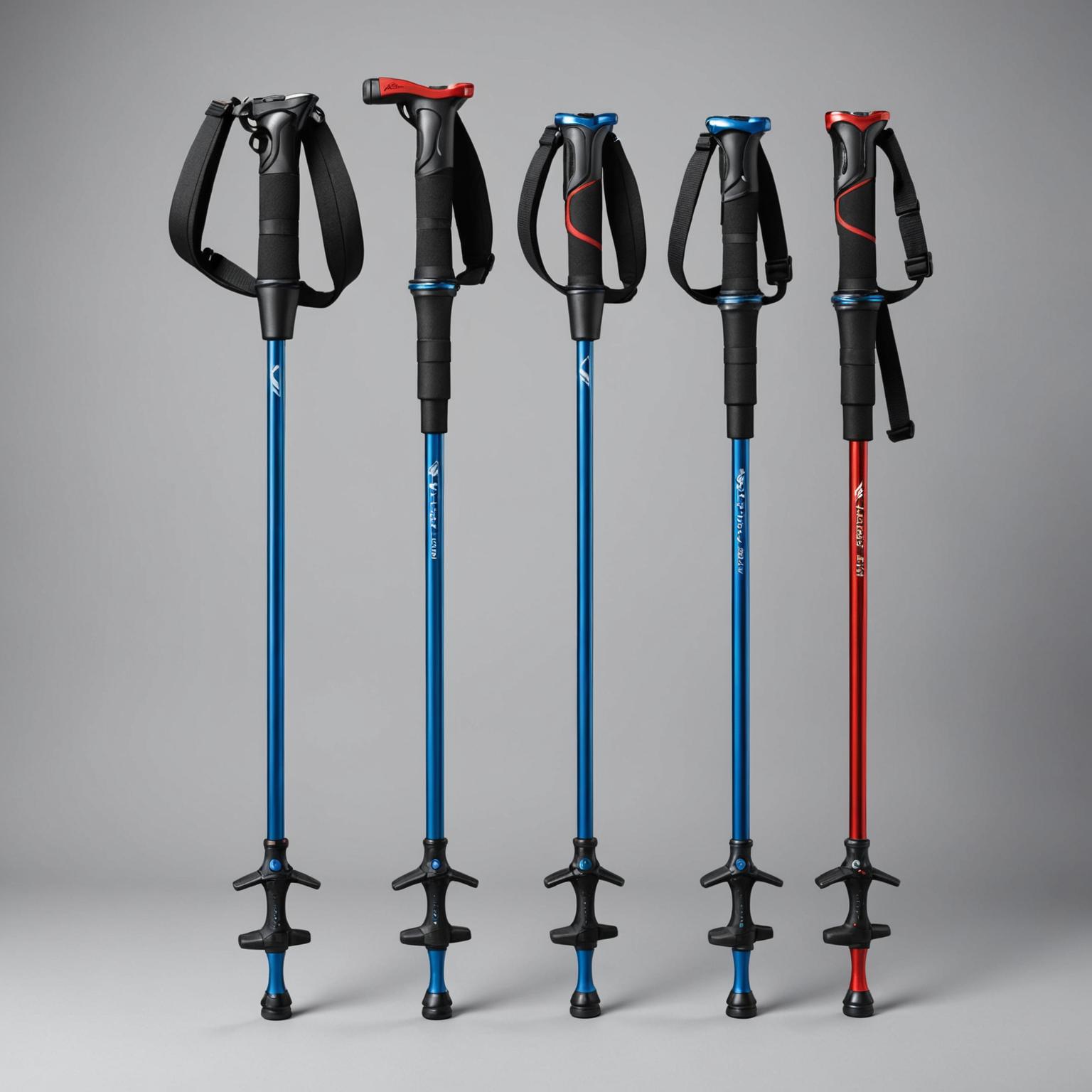Blog
Why Carbon Fiber Best Trekking Pole 509 Are a Game-Changer

Discover the Advantage of Modern Best Trekking Pole 509
Embarking on an outdoor adventure, whether it’s a challenging mountain ascent or a leisurely park stroll, is an experience enhanced by the right equipment. Among the most transformative gear for any hiker are trekking poles. They provide stability, reduce strain on your joints, and boost your overall endurance. While premium options like carbon fiber trekking poles are highly sought after for their ultralight properties, the most important factors are design, functionality, and durability, which are hallmarks of any quality set of poles.

Best Trekking Pole 509
Choosing Your Material: Strength and Weight
When selecting trekking poles, the material is a critical factor influencing both weight and durability. Aviation-grade aluminum is a popular choice, striking an excellent balance between lightweight design and robust strength. This material ensures poles can endure rugged terrains and steep climbs without adding excessive weight to your gear. (Best Trekking Pole 509)
Carbon fiber trekking poles, on the other hand, are prized for their ultra-lightweight properties. They excel at absorbing vibrations, enhancing comfort during extended treks. However, their lighter construction may compromise durability on particularly demanding trails. (Best Trekking Pole 509)
Aluminum poles are engineered for reliability, making them ideal for adventurers of all experience levels. Their resilience against rocks, roots, and uneven surfaces ensures consistent performance. This durability makes them a trusted companion for diverse outdoor activities.
For beginners, aluminum poles offer a cost-effective and dependable option. They resist bending or breaking under pressure, unlike some carbon fiber models that may crack under heavy stress. This makes aluminum a practical choice for those new to trekking. (Best Trekking Pole 509)
Carbon fiber poles, while more expensive, appeal to seasoned hikers prioritizing minimal weight. Their vibration-dampening qualities reduce strain on wrists and arms during long journeys. Yet, they require careful handling to avoid damage on rocky paths. (Best Trekking Pole 509)
The choice between aluminum and carbon fiber often depends on the type of terrain you’ll encounter. Aluminum excels in rugged, rocky environments where durability is paramount. Carbon fiber suits long-distance treks on smoother trails where weight savings are crucial.
Weight is a significant consideration for backpackers carrying gear for multi-day trips. Aluminum poles, though slightly heavier than carbon fiber, remain lightweight enough for most hikers. Their sturdiness ensures they won’t fail when you need them most. (Best Trekking Pole 509)
Trekking poles also vary in design features, such as adjustable lengths and grip materials. Aluminum poles often come with ergonomic cork or foam grips for comfort and sweat absorption. These features enhance usability across different weather conditions.
Adjustability is another key aspect when choosing trekking poles. Most aluminum and carbon fiber poles offer telescopic designs, allowing users to customize length based on height or terrain. This adaptability ensures optimal leverage and balance on ascents and descents. (Best Trekking Pole 509)
Locking mechanisms play a vital role in pole performance. Flick-lock systems, common in aluminum poles, provide secure and quick adjustments. Carbon fiber poles may use twist-lock mechanisms, which are lighter but may require more maintenance. (Best Trekking Pole 509)
The shaft design also affects pole performance. Aluminum poles typically feature a thicker shaft for added strength, while carbon fiber poles have a slimmer profile for reduced weight. Both designs cater to different hiking preferences and conditions. (Best Trekking Pole 509)
Trekking pole tips are another critical component. Carbide or steel tips, often found on aluminum poles, offer excellent traction on rocky or slippery surfaces. Carbon fiber poles may use similar tips but require regular inspection to prevent wear. (Best Trekking Pole 509)
Baskets at the base of trekking poles prevent sinking into soft ground, like mud or snow. Aluminum poles often include interchangeable baskets for versatility across seasons. This adaptability makes them suitable for year-round adventures. (Best Trekking Pole 509)
Comfort is paramount during long treks, and pole weight distribution matters. Aluminum poles provide a balanced feel, reducing fatigue over extended periods. Carbon fiber poles, with their lighter tips, minimize swing weight for faster movements. (Best Trekking Pole 509)
For winter trekking, aluminum poles are often preferred due to their cold-weather resilience. They withstand freezing temperatures without becoming brittle, unlike some carbon fiber models. This makes them a go-to choice for snowy or icy trails. (Best Trekking Pole 509)
Portability is another factor to consider. Both aluminum and carbon fiber poles often feature collapsible designs for easy storage. Aluminum’s slightly heavier build doesn’t significantly impact packability, making it a practical option. (Best Trekking Pole 509)
The cost of trekking poles varies widely based on material and features. Aluminum poles are generally more affordable, offering excellent value for budget-conscious hikers. Carbon fiber poles, while pricier, cater to those seeking premium performance. (Best Trekking Pole 509)
Environmental conditions also influence material choice. Aluminum poles resist corrosion in wet or humid environments, ensuring longevity. Carbon fiber poles may require extra care to prevent damage from prolonged exposure to moisture.
When choosing trekking poles, consider your hiking frequency and intensity. Frequent hikers may prefer carbon fiber for its lightweight benefits, while occasional trekkers may opt for aluminum’s durability. Both materials cater to different needs and preferences. (Best Trekking Pole 509)
Proper maintenance extends the life of trekking poles. Aluminum poles require minimal upkeep, with occasional cleaning to remove dirt. Carbon fiber poles need regular checks for cracks or wear, especially after heavy use. (Best Trekking Pole 509)
Trekking poles enhance stability, reduce joint impact, and improve endurance. Aluminum poles provide a reliable, all-purpose solution for most hikers. Carbon fiber poles offer specialized benefits for those prioritizing weight and comfort. (Best Trekking Pole 509)
Ultimately, the best trekking pole material depends on your specific needs. Aluminum offers unmatched durability for rugged adventures, while carbon fiber excels in lightweight performance. Assessing your hiking style and terrain will guide your decision. (Best Trekking Pole 509)
Designed for Comfort on Long Treks
Ergonomic design is crucial for trekking pole comfort, significantly enhancing your trail experience. Well-contoured EVA foam grips mold to your hand’s natural shape, ensuring a secure hold. These grips resist sweat, preventing slips in extreme weather conditions. (Best Trekking Pole 509)
Padded wrist straps are another essential feature, providing critical support during long treks. They distribute pressure evenly, reducing strain on wrists and forearms. This design element is vital for maintaining comfort over extended distances. (Best Trekking Pole 509)
Beyond material, the choice between aluminum and carbon fiber impacts ergonomic performance. High-grade aluminum poles offer durability with ergonomic grips for reliable handling. Carbon fiber poles, being lighter, pair well with advanced grips for reduced fatigue.
The grip material significantly affects comfort and control. EVA foam, commonly used in high-end poles, absorbs moisture and provides cushioning. This ensures your hands remain comfortable, even after hours of use on rugged trails.
Cork grips are another popular option, offering a natural feel and excellent sw (Best Trekking Pole 509)eat absorption. They conform to your hand over time, enhancing grip security. This makes them ideal for hikers tackling varied terrains and climates.
Rubber grips, while less common, provide a firm hold in wet conditions. However, they may cause discomfort during prolonged use due to less cushioning. EVA foam and cork remain superior for long-term comfort. (Best Trekking Pole 509)
Wrist straps must be adjustable to accommodate different hand sizes and preferences. Padded straps with breathable materials reduce chafing and enhance comfort. Proper adjustment ensures optimal support without restricting movement. (Best Trekking Pole 509)
The pole’s shaft design also contributes to ergonomics. A slightly curved shaft aligns with your natural arm motion, reducing strain. Both aluminum and carbon fiber poles can incorporate this feature for better handling. (Best Trekking Pole 509)
Adjustable telescopic poles enhance ergonomic versatility, allowing length customization. This adaptability ensures proper posture on ascents and descents, minimizing joint impact. Most high-end poles offer smooth adjustment mechanisms for ease of use. (Best Trekking Pole 509)
Locking systems, such as flick-locks or twist-locks, affect usability. Flick-locks, common in aluminum poles, offer quick and secure adjustments. Carbon fiber poles may use lighter twist-locks, requiring careful maintenance for reliability.
Pole weight influences ergonomic performance, especially on long hikes. Carbon fiber pol (Best Trekking Pole 509)s, being lighter, reduce arm fatigue when paired with ergonomic grips. Aluminum poles, though slightly heavier, maintain balance with sturdy designs.
Trekking pole tips also play a role in ergonomics by ensuring stability. Carbide tips provide traction, reducing wrist strain on uneven terrain. Interchangeable tips allow adaptation to various surfaces, enhancing user control. (Best Trekking Pole 509)
Baskets at the pole’s base prevent sinking in soft ground, improving balance. Larger baskets suit snow or mud, while smaller ones work for rocky trails. This versatility supports ergonomic stability across conditions. (Best Trekking Pole 509)
The angle of the grip can further enhance comfort. Angled grips, often found in high-end poles, align with your wrist’s natural position. This reduces strain during repetitive motions, ideal for long-distance trekkers. (Best Trekking Pole 509)
Vibration dampening is a key ergonomic feature, particularly in carbon fiber poles. This reduces shock transmitted to your hands and arms on hard surfaces. Aluminum poles, while less dampening, can include foam cores for similar benefits. (Best Trekking Pole 509)
Portability enhances the overall trekking experience. Collapsible poles, common in both materials, fit easily into backpacks. Ergonomic designs ensure that portability doesn’t compromise comfort or functionality. (Best Trekking Pole 509)
Pole length adjustment is critical for ergonomic efficiency. Poles that are too long or short can strain your shoulders or back. Proper sizing, guided by elbow angle, ensures optimal posture and reduced fatigue. (Best Trekking Pole 509)
Maintenance of ergonomic features is straightforward but essential. Cleaning grips prevents sweat buildup, maintaining their effectiveness. Regular inspection of straps and locks ensures long-term reliability and comfort. (Best Trekking Pole 509)
Environmental factors, like temperature, impact grip performance. EVA foam and cork grips perform well in both hot and cold conditions. This reliability ensures consistent comfort regardless of weather challenges. (Best Trekking Pole 509)
For winter trekking, ergonomic poles with larger baskets and durable grips excel. Aluminum poles with padded straps withstand cold without compromising comfort. Carbon fiber poles require extra care to maintain grip integrity in freezing temperatures.
Cost considerations often influence ergonomic choices. High-end aluminum poles with advanced grips offer excellent value. Carbon fiber poles, while pricier, provide superior lightweight ergonomics for dedicated hikers.
Trekking poles reduce joint impact by up to 25%, according to studies. Ergonomic designs amplify this benefit by ensuring proper hand and wrist alignment. This makes them indispensable for long-term joint health. (Best Trekking Pole 509)
The choice between aluminum and carbon fiber should factor in ergonomic needs. Aluminum offers robust, budget-friendly options with reliable grips. Carbon fiber excels for those prioritizing lightweight comfort on extended treks. (Best Trekking Pole 509)
Ultimately, ergonomic trekking poles enhance stability, comfort, and endurance. Thoughtful design features like EVA foam grips and padded straps ensure lasting performance. Choosing the right pole depends on your hiking style and terrain preferences.
Versatility for Every Adventure
Modern trekking poles are designed for supreme adaptability, catering to diverse terrains and user needs. A telescopic adjustability system with a secure locking mechanism allows precise height customization. This ensures optimal performance for varying heights and trail conditions. (Best Trekking Pole 509)
Adjustable poles enhance efficiency, enabling shorter settings for uphill climbs and longer ones for descents. Flick-lock mechanisms, common in aluminum poles, provide quick and reliable adjustments. Carbon fiber poles may use twist-locks, which are lightweight but require careful maintenance. (Best Trekking Pole 509)
Versatility in trekking poles is defined by their ability to handle multiple surfaces. Interchangeable tips, such as carbide or rubber, ensure traction on rocks, snow, mud, or pavement. This multi-terrain functionality makes poles suitable for year-round adventures.
Aluminum poles offer robust durability, making them ideal for rugged, rocky paths. Their sturdy construction withstands heavy use without compromising adjustability. This reliability suits adventurers tackling unpredictable environments.
Carbon fiber poles, known for their lightweight design, excel in long-distance treks. Their adaptability to smooth or moderately rough trails is enhanced by flexible tip options. However, they require cautious use on jagged surfaces to avoid damage. (Best Trekking Pole 509)
The ability to adjust pole length quickly is crucial for dynamic terrains. A well-design (Best Trekking Pole 509)ed locking system ensures stability during rapid changes in elevation. This feature reduces strain and improves balance on steep slopes.
Interchangeable baskets at the pole’s base enhance adaptability for soft surfaces. Larger baskets prevent sinking in snow or mud, while smaller ones suit rocky trails. This versatility ensures consistent performance across seasons.
Ergonomic grips complement adaptability by providing comfort during extended use. EVA foam or cork grips absorb sweat and maintain a secure hold. These grips pair well with adjustable systems for seamless handling. (Best Trekking Pole 509)
Pole tips are critical for multi-terrain functionality. Carbide tips grip rocky surfaces effectively, while rubber tips protect paved trails and reduce noise. Swappable tips allow hikers to adapt to changing conditions effortlessly.
The weight of trekking poles impacts their adaptability for long journeys. Ca (Best Trekking Pole 509)rbon fiber poles, being lighter, are ideal for multi-day hikes with frequent adjustments. Aluminum poles balance weight and durability for mixed terrains.
Telescopic poles collapse for easy storage, enhancing portability. This feature is vital for backpackers transitioning between trails and campsites. Both aluminum and carbon fiber poles offer compact designs without sacrificing strength. (Best Trekking Pole 509)
Locking mechanisms must withstand environmental challenges like dust or moisture. Flick-locks on aluminum poles resist debris, ensuring smooth adjustments. Twist-locks on carbon fiber poles need regular cleaning for optimal performance.
Adaptable poles reduce physical strain by supporting proper posture. Adjusting pole length to match terrain gradients minimizes stress on joints. This makes them essential for long-term health during frequent hikes. (Best Trekking Pole 509)
Multi-terrain poles are equipped with shock-absorbing features for added comfort. Some aluminum poles include internal springs to cushion impacts on hard surfaces. Carbon fiber poles naturally dampen vibrations, enhancing adaptability.
Seasonal adaptability is a key advantage of modern trekking poles. Poles with snow baskets and durable tips excel in winter conditions. Aluminum’s resilience in cold weather makes it a preferred choice for snowy trails.
Portability and adjustability go hand in hand for versatile trekking poles. Collapsible designs fit into backpacks, while telescopic systems allow on-the-go tweaks. This combination supports hikers in dynamic environments. (Best Trekking Pole 509)
Cost is a factor when choosing adaptable trekking poles. Aluminum poles offer affordable versatility with reliable locking systems. Carbon fiber poles, though pricier, provide lightweight adaptability for dedicated trekkers. (Best Trekking Pole 509)
Maintenance ensures long-term adaptability of trekking poles. Regular cleaning of locking mechanisms prevents jamming from dirt or grit. Checking tips and baskets for wear maintains performance across diverse terrains.
Environmental conditions influence pole adaptability. Aluminum poles resist corrosion in wet or humid climates, ensuring reliable adjustments. Carbon fiber poles require protection from prolonged moisture to maintain integrity. (Best Trekking Pole 509)
Trekking poles enhance stability by up to 30% on uneven terrain, studies suggest. Adjustable systems and multi-terrain tips maximize this benefit. They ensure confident navigation across challenging landscapes. (Best Trekking Pole 509)
For beginners, aluminum poles with simple flick-locks offer user-friendly adaptability. Seasoned hikers may prefer carbon fiber for its lightweight, adjustable precision. Both materials cater to diverse trekking styles.
The ergonomic design of adjustable poles enhances their versatility. Grips that conform to hand shapes reduce fatigue during length adjustments. Padded wrist straps further support comfort on varied trails. (Best Trekking Pole 509)
Ultimately, adaptable trekking poles are indispensable for outdoor exploration. Their telescopic systems and multi-terrain features ensure performance in any condition. Choosing the right pole depends on your hiking goals and terrain preferences. (Best Trekking Pole 509)
Elevate Your Outdoor Experience
Ultimately, investing in a pair of high-quality trekking poles is about more than just support; it’s about transforming your outdoor adventures. With their stunning designs, durable materials, and thoughtful focus on user comfort and adaptability, these poles are more than just tools. They are reliable partners that empower you to push your limits, explore further, and conquer your next journey in style and with confidence. Whether you are a seasoned mountaineer or a weekend walker, the right trekking poles will elevate your experience, making every step more stable, comfortable, and enjoyable.
Discover Durable Aluminum Trekking Poles in Bulk
-
Posted by
Betty Wang
- 0 comments
1.Discover Aluminum Trekking Poles for Bulk Adventures
2.Why Choose Aluminum Trekking Poles?
3.Improve Your Outdoor Experience
4.Complete Gear for Every Expedition
Elevate Trek Adventures with Aluminum Trekking Poles Bulk
-
Posted by
Betty Wang
- 0 comments
1. Elevate Your Hiking Experience with Aluminum Trekking Poles in Bulk
2. The Role of Quality Gear in Hiking
3. Why Aluminum Trekking Poles Are Essential
4. Purchasing in Bulk: Convenience for Outdoor Enthusiasts
5. Conquer New Horizons with Complete Hiking Gear
Maximize Adventures with Aluminum Trekking Poles Bulk
-
Posted by
Betty Wang
- 0 comments
1. Enhance Your Hiking Experience with Aluminum Trekking Poles
2. Optimizing Stability on Rugged Trails
3. Bulk Purchases for Group Adventurers
4. Complementing Outdoor Gear
5. Conclusion: Gear Up for Adventure
Aluminum Trekking Poles Bulk: The Ultimate Hiking Essential
-
Posted by
Betty Wang
- 0 comments
1. Exploring the Benefits of Aluminum Trekking Poles in Bulk
2. Features of Aluminum Trekking Poles That Stand Out
3. Introducing the Summit Series Pro X Outdoor Gear Collection
4. Why Buy Aluminum Trekking Poles in Bulk?
5. Conclusion: Elevate Your Outdoor Adventures
Best Trekking Pole 134 for Mountain Climbing Wholesale Gear
-
Posted by
Betty Wang
- 0 comments
1. Essential Gear for Adventurers: Trekking Poles and More
2. Unmatched Performance with a Complete Adventure Outfit
3. Functional Style: Pants, Backpack, and Trekking Poles
4. Complete Your Look: Footwear and Gloves
5. Conquer Nature with Confidence
Trunk Bike Rack Wholesale: A Smart Business Move
-
Posted by
Betty Wang
- 0 comments
1. Meeting the Demand for Cycling Adventure
2. The Practical Appeal of Trunk-Mounted Racks
3. The Strategic Benefits of Wholesale Purchasing
4. Choosing the Right Wholesale Partner
Trunk Bike Rack Wholesale: Boost Your Retail Business
-
Posted by
Betty Wang
- 0 comments
1. The Universal Appeal of Trunk-Mounted Bike Racks
2. A Lucrative Opportunity for Retailers
3. What to Look for in a Wholesale Supplier
4. Equipping the Modern Explorer for the Road Ahead
Trunk Bike Rack Wholesale: Essential for Outdoor Enthusiasts
-
Posted by
Betty Wang
- 0 comments
1. The Gateway to Adventure for Your Customers
2. Why Trunk Racks are a Versatile and Popular Choice
3. Essential Features for Quality Wholesale Racks
4. The Business Advantages of Buying in Bulk
Trunk Bike Rack Wholesale: Key to Adventure Growth
-
Posted by
Betty Wang
- 0 comments
1. Why Trunk Racks are a Popular Choice
2. Meeting Market Demand: The Wholesale Advantage
3. What to Look for in a Wholesale Supplier
4. Capitalizing on the Adventure Trend
Trunk Bike Rack Wholesale: Versatile Solutions for Adventure
-
Posted by
Betty Wang
- 0 comments
1. Tapping into the Cycling Boom with Wholesale Solutions
2. The Versatility and Appeal of Trunk-Mounted Bike Racks
3. The Strategic Advantage of Buying Wholesale
4. Choosing the Right Wholesale Supplier
5. Equipping the Modern Adventurer
Trunk Bike Rack Wholesale: Boost Your Retail Market
-
Posted by
Betty Wang
- 0 comments
1. The Growing Demand for Accessible Cycling Solutions
2. Key Advantages for Retailers and Consumers
3. What to Look for in a Trunk Bike Rack Wholesale Partner
4. Capitalizing on a Thriving Market
Trunk Bike Rack Wholesale: Gear Up for Adventure
-
Posted by
Betty Wang
- 0 comments
1. The Epitome of Adventure-Ready Design
2. Versatile Solutions for Every Vehicle
3. Capitalizing on the Outdoor Lifestyle Trend
4. Equipping the Next Generation of Explorers











